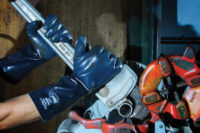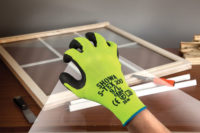Inattention is a huge contributor to workplace injuries, so it is important to continually remind workers of the risks associated with a task and to challenge them to pay attention. Beyond this, it is essential to provide properly fitting protective gloves and to make sure your employees are wearing them.
Because no single glove provides protection from all types of hand injuries, selection is based on performance characteristics of the glove in relation to the task.
In the meat processing and metal fabrication industries, for example, these might be cut-resistant gloves. Gloves with barrier protection are critical to the health care industry, and gloves that absorb oil for sure grip are key in the automotive industry. Chemical-resistant gloves are available to meet the varying chemical resistance requirements of different tasks and to protect the hands of everyone from the janitorial staff to those working in the swimming pool industry.
Create a safety culture
How do you implement a hand safety program that achieves a high level of awareness and makes wearing PPE second nature? The answer lies in creating a safety culture that penetrates every level of your organization.
C-level commitment to safety is probably the best catalyst in creating this comprehensive safety culture. For more and more companies, that means adopting a far-reaching “zero harm” credo that communicates: “We’re committed to zero harm to our people, the environment and the communities in which we operate.” This credo goes well beyond hand safety and makes it clear that management is concerned about worker well being and is committed to achieving it.
Creating tour program
Whether you develop your program in-house or outsource the work, a successful program requires that every task be evaluated in terms of risks, safety protocols and personal protective equipment (PPE) requirements. This is a challenging responsibility that cannot be managed from an ivory tower. Instead, it requires the involvement of workers, team leaders, superintendents and anyone else who can provide valuable input. Comprehensive worker surveys can uncover the information necessary to determine your unique safety requirements and best practices. Safety protocols can then be documented and PPE prescribed department-by-department and position-by-position.
Once the program is down on paper, the hard work begins. But the challenges can be simplified by using the following steps to design a comprehensive program to sell your entire workforce on hand safety:
- Create worker information sheets that make hand protection protocols understandable.
- Establish a safety board that includes members from all stakeholder groups in the organization from the factory floor to the executive suite.
- Train workers on hand protection, including glove selection, glove storage and techniques for testing previously worn hand protection to be certain it is still effective.
- Make it easy for workers to obtain the proper hand protection for their specific tasks through convenient glove stocking and intuitive labeling.
- Use every internal communication vehicle available to you to promote hand protection, including:
In 2001, the Canadian Petroleum Safety Council introduced its “Green Hand/Gold Hand” initiative to reduce injuries among inexperienced workers. Using the following four steps, this program makes use of green and gold stickers to keep the safety initiative top-of-mind on the work floor:
- Ensure that all new workers receive a health and safety orientation. New workers are given a “green hand” sticker to place on their hard hats. This signifies that a worker is new and may need extra assistance and guidance with working safely.
- After a probationary period, all new workers must complete a written test to assess their knowledge of the information covered in their health and safety orientation.
- Once new workers demonstrate their knowledge of the safety program, they graduate out of the “green hand” sticker.
- Workers may then opt to wear a “gold hand” sticker that signifies that he or she has demonstrated a strong commitment to personal safety and the safety of fellow employees.





